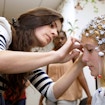Unexpected Forces Cause Rotor Proteins to Self-Organize
Self-organizing systems surround us, from the synchronization of a flock of birds to the dance of the cellular scaffolding known as the cytoskeleton. Deemed ‘active matter,’ self-organizing systems hold enticing stories. How do things become self-organized? And is that self-organization biologically relevant?
These questions are part of what led Michael Shelley, director of the Flatiron Institute’s Center for Computational Biology, and his team to investigate the conditions required for the self-organization of rotating inclusions within a simulated membrane, a model system for the ATP synthase proteins that rotate within a cell’s mitochondrial membranes. In a paper published on October 3 in Physical Review Letters, Shelley and his team showed that a combination of the proteins’ rotation and repulsion resulted in the formation of a lattice.
“You have all these interesting problems with things that spin and rotate,” says Shelley. Add in a membrane — essentially a 2D surface immersed in fluid — and you have a unique system where the fluid affects the flow in the membrane. Experimental studies have shown that ATP synthases self-organize, but the requirements for this self-organization have remained unknown. Although fluid dynamics are not typically thought of as relevant to crystallization, says Shelley, in this system they play a central role.
To attack the problem, Shelley and his team created a bare-bones model of the rotor proteins in a membrane to explore what, at minimum, was necessary for their self-organization.
With rotation alone, the rotors do not form an ordered system. With only repulsion, for which the researchers tested two types — purely steric (collisions only) and screened electrostatic — the system also remains disordered. However, when rotation and flow are added to the repulsion — a condition the researchers call ‘hydrosteric’ — an ordered hexagonal lattice system results.
While it is common for steric interactions alone to result in self-organization in bounded systems (picture gum balls rigid in the confines of a glass globe) or in infinite systems, here rotation provides the essential jostling and bounds the system, according to David Stein, a research scientist at the Center for Computational Biology and an author on the paper. The jostling is different from Brownian motion, which would result in the rotors moving apart from one another. Instead, the rotational movement is characterized by a so-called conserved Hamiltonian (a mathematical way to describe the energies of particles in a system) in 2D, which puts actual bounds on the positions of the rotors and restricts them from moving apart indefinitely. “The Hamiltonian in this work is a peculiarity,” says Shelley, as it’s typically a function of position and momentum, but in this case, it is just a function of the position of the particles. Naomi Oppenheimer, an assistant professor of physics at Tel Aviv University and lead author on the study, likens the chaotic rotors to gas particles, but with a bound. While an opened container of gas would result in the particles spreading, a similar container of rotors would not.
Like particles that remain suspended uniformly in solution after vigorous mixing, once the rotors are assembled into a lattice by hydrosterics, the structure is stable enough to persist when repulsion is removed, the researchers discovered. Simulations show that the lattice as a whole rotates, with the rotation rate a function of the lattice perimeter. Increasing the rotor rotation rate increases the order by minimizing the effects of thermal fluctuations. To give a real-life flavor to the simulation, the researchers used biological parameters like body temperature and features of ATP synthase to determine that a collection of ATP synthases within a cell could self-organize and avoid disruption by thermal noise.
“We’ve learned that self-organization in membranes can result from very simple interactions in a model for proteins,” says Shelley. He emphasized the importance of starting with the simplest possible model. The next step, says Oppenheimer, would be to add the effect of curvature to the model. “The mitochondrial membrane is full of curves,” she says, “whereas in this study, we modeled the system as flat.” The work could have implications for mitochondrial functioning, as some studies have shown a link between ATP synthase ordering and mitochondrial membrane potential.
Stein looks forward to trying the simulation with a greater number of rotors. Shelley discussed the importance of big, clean and accurate simulations, a benefit of working with a diverse set of researchers in an environment like the Flatiron Institute where creativity can flourish. Looking beyond the mitochondria, Oppenheimer says the most exciting part of this study is its applicability to so many different kinds of systems. She says, “We are realizing this goes deeper than membranes and applies to any system of rotating particles in a fluid state, like microscopic rotating magnets, bacteria circling near a substrate, and even atmospheric flows spanning hundreds of kilometers.”


